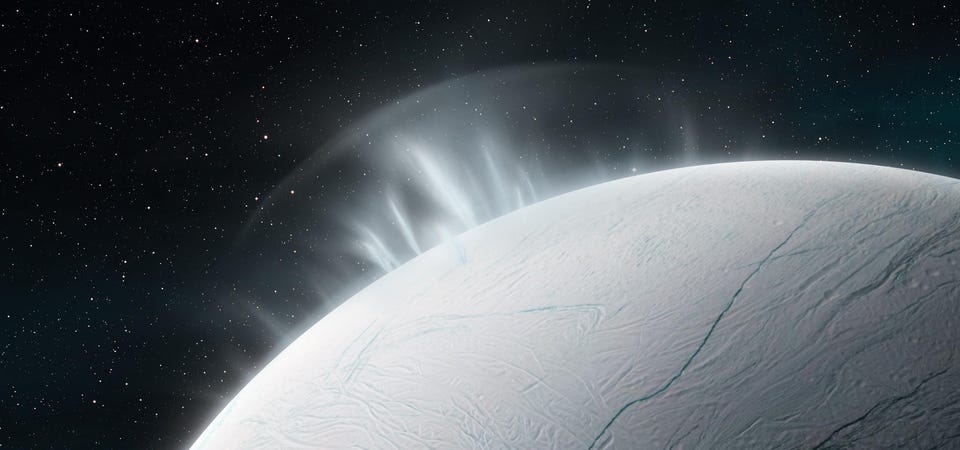Forbes Innovation Science Saturn’s Wet Moon Enceladus May Be Rapidly Flinging Microbes Into Space, Say Scientists Jamie Carter Senior Contributor Opinions expressed by Forbes Contributors are their own. I inspire people to go stargazing, watch the Moon, enjoy the night sky Following Mar 18, 2023, 08:15pm EDT | Press play to listen to this article! Got it! Share to Facebook Share to Twitter Share to Linkedin Enceladus — the sixth largest of Saturn’s 83 moons — has been considered by astronomers to be one of . .
. [+] the more compelling bodies in our solar system. (Illustration) Future Publishing via Getty Images Saturn’s sixth-largest moon Enceladus has a secret.
About 12 miles underneath the icy crust of this “veiny eyeball” moon is a warm, dark saltwater ocean thought to have the same kinds of hydrothermal vents found in Earth’s oceans—and where microbes thrive. Is the same thing happening on Enceladus? We’re probably not talking weird eyeless sea creatures , largely because the total biomass that the moon’s underground ocean could support may be less than that of a whale . It’s known that tiny icy silica particles from the seafloor are eventually sprayed into space from fractures in the ice known as ‘‘tiger stripes” near Enceladus’ warmer south pole.
Those particles go on to help form Saturn’s second outermost E ring. But they could also contain biosignatures—the first evidence of some kind of life beyond Earth. MORE FROM FORBES Any Biomass On Saturn’s ‘Snowball Moon’ Enceladus Could Be No Bigger Than A Whale In Total, Say Scientists By Jamie Carter However, until now planetary scientists have not known how that silica gets into space and how long it takes.
Published in Communications Earth & Environment , new research using data on Enceladus’ orbit, ocean and geology collected by NASA’s Cassini spacecraft sheds light on the process. MORE FOR YOU The Inside Story Of Papa John’s Toxic Culture Today’s ‘Heardle’ Answer And Clues For Sunday, March 19 Today’s ‘Quordle’ Answers And Clues For Sunday, March 19 It shows that it takes just a few months for tidal heating in Enceladus’ rocky core to create currents that transport the silica from deep-sea hydrothermal vents. A rendering of the sediment capture model developed in the UCLA-led study, showing buoyancy effects .
. . [+] on silica grains produced at hydrothermal vents along the sea floor and how this eventually leads to their escape through cracks in the outer ice shell.
Ashley Schoenfeld/UCLA; NASA JPL “Our research shows that these flows are strong enough to pick up materials from the seafloor and bring them to the ice shell that separates the ocean from the vacuum of space,” said Ashley Schoenfeld, group leader and a UCLA doctoral student in planetary science, in a statement . “The tiger-stripe fractures that cut through the ice shell into this subsurface ocean can act as direct conduits for captured materials to be flung into space . .
. Enceladus is giving us free samples of what’s hidden deep below. ” MORE FROM FORBES Seven Things You Need To Know About NASA’s New $4.
9 Billion Mission To Enceladus, A Tiny Moon Of Saturn By Jamie Carter There is already a mission being tentatively explored by NASA to go “taste” the silica being spewed into space. The Enceladus Orbilander mission would have a spacecraft orbit the moon twice per day for 200 days specifically to sample its plumes. Then it would land, stay on the surface for a couple of years to sample the plume material that has fallen back to the surface—and what makes Enceladus so bright and reflective.
The mission is pencilled-in for a launch in October 2038 (with a backup in November 2039) to arrive in 2050. Wishing you clear skies and wide eyes. Follow me on Twitter or LinkedIn .
Check out my website or some of my other work here . Jamie Carter Editorial Standards Print Reprints & Permissions.
From: forbes
URL: https://www.forbes.com/sites/jamiecartereurope/2023/03/18/saturns-wet-moon-enceladus-may-be-rapidly-flinging-microbes-into-space-say-scientists/



